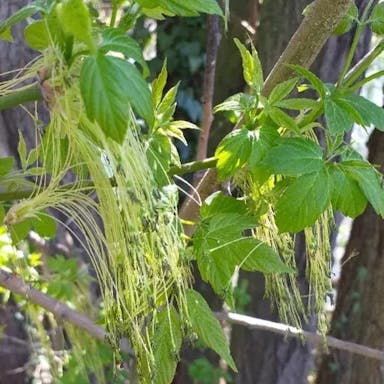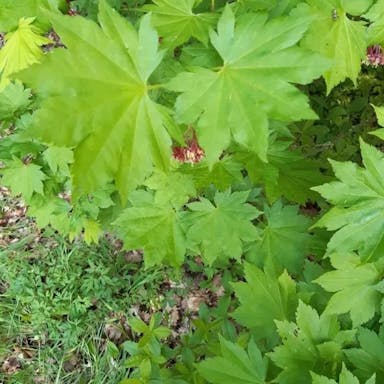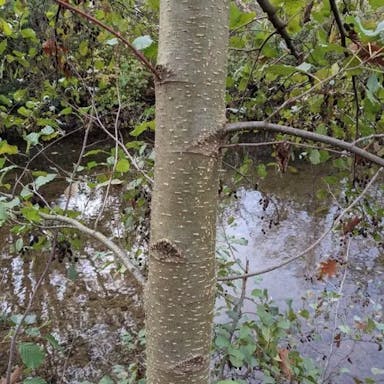Cherry birch, scientifically Betula lenta, grows across the eastern United States and southeastern Canada. This deciduous tree can reach 80 feet tall when mature, with a narrow shape when young that rounds out with age. The bark, dark and scented of wintergreen, is a distinctive feature. The leaves are green in summer, yellow in fall. In spring, cherry birch grows small flowers in catkins. The male catkins are yellowish, the female ones green. As a monoecious plant, it produces male and female flowers. In late summer or early fall, winged nutlets mature as fruit. Wind disperses them for reproduction. With easy growth and soil adaptability, cherry birch works well in landscaping. Its bark and fall color provide appeal. Its wood serves uses like furniture and veneer.
Cherry birch
- Scientific name
- Betula lenta
Basic Information
- Betulaceae Family Betula Genus Cherry birch Species
- Betulaceae > Betula > Betula lenta
- 83%
- The Completeness of This Encyclopedia
Please help us complete the encyclopedia, Terrarium is a encyclopedia service to be completed with everyone in the world. Currently, this page is 83% complete. For more information on how to contribute, please click here.
- Broad-leaved tree
- Tree
- Height
- 2000cm ~
- Flower Color
- Leaf Color
- Anthesis
- spring
- Sunlight Exposure
Full Sun Long hours of sunlight from morning to afternoon Partial Shade A location in the shade of a tree or where either the morning or afternoon is shaded Full Shade A place where there is no direct sunlight
- Full Sun
- Hardiness Zones
This is an indicator to know to which zone each plant can winter. Knowing the zone of each plant gives you an idea of the cold temperature resistance when grown in the ground without a roof. 2: -42.7 to -40.0 3: -39.9 to -34.4 4: -34.3 to -28.9 5: -28.8 to -23.3 6: -23.2 to -17.8 7: -17.7 to -12.2 8: -12.1 to -6.7 9: -6.6 to -1.1 10: -1.0 to 4.4 11: 4.5 to 10.0
- 3
- Cold resistance
- Excellent
- Heat resistance
- Fair
- Habitat of origin
- United States
- Growth Rate
- Normal
What is Cherry birch (Betula lenta)?
What is Cherry birch (Betula lenta)
Flower meaning
The North American Cherry birch plant signals the meaning of Expectation and Restoration. This conveys positive thinking, fresh starts, and conviction in an enhanced tomorrow. It frequently communicates support, flexibility, and conquering difficulties. The Cherry birch's dainty blooms and lively hues represent charm and possibilities emerging from taxing situations. This is notably applicable during periods of alteration or when commencing novel phases in life.
Calendar of Cherry birch (Betula lenta)
Calendar
The deciduous Cherry birch native to the United States, scientifically known as Betula lenta, produces typically inconspicuous small flowers arranged in catkins. It blooms during the months of April and May in the spring season. During mid to late spring, the blooming period reaches its peak and lasts for a few weeks. To ensure a longer blooming period, pruning the tree during the dormant season helps promote better flowering in the following year. Providing adequate sunlight, water, and nutrients is recommended. The flowering time and season may vary slightly depending on the specific geographical location within the United States.
How to grow Cherry birch (Betula lenta)
Watering
The ideal frequency and technique for providing water to the Cherry birch depends on various elements, counting seasonal changes, dirt dampness, and the explicit requirements of the plant life. During the development period, that typically develops starting from spring until fall, the Cherry birch requires habitual provision of water to uphold dirt moisture. It is suggested to supply the plant life with water profoundly, guaranteeing that the water contacts the root zone. This could be accomplished by providing the plant life with water gradually and uniformly, permitting the water to enter the dirt. The recurrence of providing water will rely on upon the climate conditions and the dampness level of the dirt. As an expansive rule, the Cherry birch should be provided with water when the top inch of dirt feels dry to the contact. It is vital to evade overwatering, as this may prompt root rot and other issues. During the lethargic period, which happens in winter, the Cherry birch requires less incessant provision of water. It is vital to screen the dirt dampness and just provide water when essential to forestall the plant life from drying out. By and large, keeping up a steady level of dirt dampness is basic for the wellbeing and essentialness of the Cherry birch plant life.
Soil and Fertilizer
Cherry birch, scientifically known as Betula lenta, thrives in moist, well-drained soils with a slightly acidic to neutral pH level ranging from 5.5 to 7.0. It prefers loamy or sandy soils that are rich in organic matter. The soil should be kept consistently moist, but not waterlogged, as excessive moisture can lead to root rot. To promote healthy growth and development, Cherry birch benefits from regular fertilization. A balanced slow-release fertilizer with an NPK ratio of 10-10-10 or 14-14-14 is recommended. The fertilizer should be applied in early spring before new growth begins and again in late spring or early summer. Regular soil testing is essential to monitor the nutrient levels and pH of the soil. Adjustments to the fertilizer application may be necessary based on the test results. It is important to follow the manufacturer's instructions for proper application and to avoid over-fertilization, which can harm the tree.
Sunlight and Place
Cherry birch is known by its scientific name - Betula lenta. This deciduous tree can handle various conditions. It does well in low temperatures. Expert gardeners say it can even survive -30°F(-34°C). However, it struggles in intense heat. Cherry birch grows best at 60-75°F(15-24°C). During summer, watering helps the soil stay moist. Proper mulching is key. It keeps the roots from temperature extremes. Come winter, freezing is no issue for this hardy tree. No special care is required. Full sun to light shade is ideal for Cherry birch. It can manage some shade. But too much blocks growth and blooms. At minimum, 6 hours of direct light daily is recommended. This ensures the tree thrives fully. To summarize, cold is no problem for tough Cherry birch. However, extreme heat may be challenging. It prefers full sun to partial shade. Providing adequate light and summer water enables healthy development.
Advanced Information of Cherry birch (Betula lenta)
Pruning
Cherry birch, scientifically known as Betula lenta, is a deciduous tree that benefits from regular pruning and cutting back. The best time for pruning is during late winter or early spring, before new growth begins. Monitoring the tree for signs of problems is needed. Careful pruning helps keep the tree healthy and looking good.
Planting and Harvest
Cherry birch, also known as Betula lenta, is a deciduous tree. When potting Cherry birch, choose a 2 feet deep and wide, well-drainage container. Fill the pot with well-draining mix, place the tree in center, level root ball with top of pot. Gently firm soil around roots. Water thoroughly after planting, keep soil moist. Plant Cherry birch in full sun to partial shade and well-draining soil. Dig hole twice as wide and deep as root ball. Place tree in hole, level with ground. Gently firm soil around roots. Water thoroughly after planting, mulch around base. Repot Cherry birch, choose larger container, follow same potting procedure. Repot every 2-3 years for root growth space. Mishowing can decline Cherry birch. Water regularly, avoid overwatering, waterlogging. Prune late winter or early spring, remove dead, damaged, crossing branches. Fertilize early spring with slow-release balanced fertilizer. Cherry birch thrives potted and in-ground with proper care, conditions.
Propagation
Cherry birch can be propagated through various methods such as sowing seeds, division, cuttings, and leaf cuttings. It is possible to propagate by sowing seeds. In autumn, gather ripe seeds from the tree and plant them in a container with a well-draining growing medium. Keep the soil moist. Put the container somewhere cool so the seeds go through a cold period. After this cold period, move the container to a warm bright spot so the seeds can germinate. For division, carefully dig up the plant. Break the clumps into smaller pieces, making sure each piece has roots and shoots. Replant the divisions in prepared soil. Water them thoroughly. To propagate with cuttings, take 6-8 inch long stem pieces from new growth. Remove the lower leaves. Dip the cut end in rooting hormone. Put the cuttings in a container with well-draining soil. Keep them somewhere warm and humid until roots form. It is also possible to use leaf cuttings. Take healthy leaves. Cut them into sections, making sure each section has a vein. Place the leaf sections on moist soil. Cover them to maintain humidity. Keep the soil moist. Wait for new plantlets to form at the base of the leaf sections. The propagated plants can be harvested when they are big enough to be transplanted or to keep growing.
Pests and Diseases
Cherry birch, also known as Betula lenta, is vulnerable to some insects and diseases. One pest that affects this plant is the bronze bug (Agrilus anxius). This bug gets into the trunk and branches of the cherry birch, causing harm to the vascular system and finally resulting in the decline and end of the tree. To stop this bug, it is important to keep the overall health of the tree by providing proper water, fertilizer, and cutting. Also, avoiding stress like drought and damage can help reduce the chance of bronze bug problems. Another issue that can affect cherry birch is the birch leaf spot disease, caused by the fungus (Gloeosporium betularum). This disease causes dark spots to show up on the leaves, which can eventually lead to losing leaves and weaken the tree. To stop birch leaf spot disease, it is recommended to have good cleanliness by removing fallen leaves and debris from around the tree. Fungus treatments may also be applied as a preventive measure. Lastly, cherry birch can be at risk for root rot, caused by various soil-borne pathogens like (Phytophthora spp.) and (Armillaria spp.). This disease affects the roots, leading to poor nutrient uptake and water absorption, resulting in the withering and decline of the tree. To prevent root rot, it is important to ensure proper drainage and avoid overwatering. Planting cherry birch in well-drained soil and avoiding too much mulch around the base of the tree can also help reduce the risk of root rot.
Habitat of Cherry birch (Betula lenta)
Habitat
Toxicity of Cherry birch (Betula lenta)
Health Benefits
- edible
- Inedible
- Toxic
- No toxicity
NO DATA
Toxic for dogs and cats
NO DATA
Q&A of Cherry birch (Betula lenta)
- What Are the Uses of Cherry Birch Wood?
Cherry Birch wood, scientifically known as Betula lenta, is highly valued for its multiple uses. Production workers appreciate its strength and attractive grain. Products include kitchen tools, bedroom cabinets, and sidewalk planks. The oil holds a sweet smell used in perfume. Bark pieces brew medicinal tea.
- How to Identify Cherry Birch Bark?
Cherry Birch bark, scientifically known as Betula lenta, can be identified by its dark, almost black color and its smooth texture. The fragrant bark often peels off in horizontal strips, revealing a reddish-brown inner bark. This unique feature helps distinguish the Cherry Birch from other trees. However, the bark's appearance may vary with age and environment.
- What Do Cherry Birch Leaves Look Like?
Cherry Birch leaves called Betula lenta have oval to elliptical shape. The leaves turn yellow in fall. They are dark green on top and lighter green below. The veins extend from midrib to leaf edge. The African violet has leaves that are heart or oval shaped. The leaves are slightly hairy and fleshy. African violets are grown as houseplants. They come in many colors like purple, pink, white and blue. African violets require well-drained soil and indirect sunlight. Overwatering can cause root rot. Fertilizer should be applied monthly during growing season.
- Is there a recommended way to choose Cherry birch?
Cherry birch, scientifically known as Betula lenta, is a deciduous tree native to North America. When selecting varieties to plant, it is important to evaluate characteristics. 'Heritage' provides attractive bark and fall color. 'Madison' resists beetle damage. 'Purpurea' gives unique purple leaves. When choosing seeds, opt for fresh, plump ones from a trusted source. Look for healthy root systems and branches on seedlings. Avoid diseased plants. Careful selection ensures planting success.











